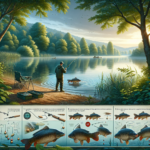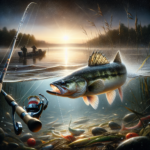Fishing Tips on How to Catch Bluegill

Introduction
Bluegill (Lepomis macrochirus) is a popular freshwater fish species known for its vibrant colors and feisty nature. This species is a favorite among anglers, both novice and experienced, due to its abundance and the challenge it presents. Bluegill fishing is not only a recreational activity but also a gateway for many into the world of angling. This article will provide a comprehensive guide on how to catch bluegill, covering everything from their physical characteristics and habitats to the best fishing techniques, gear recommendations, and common mistakes to avoid.
Fish Species Overview
Description
Bluegill are easily recognizable by their deep, laterally compressed bodies and a distinctive dark spot at the base of their dorsal fin. They typically range in size from 6 to 10 inches, though larger specimens can reach up to 12 inches. Their coloration varies but generally includes shades of blue and green on the upper body, with a yellow or orange belly. Males often exhibit more vibrant colors, especially during the spawning season.
Habitat
Bluegill thrive in freshwater environments such as lakes, ponds, rivers, and streams. They prefer areas with abundant vegetation, which provides cover and food sources. Bluegill are commonly found in North America, particularly in the eastern and central United States. They are adaptable and can live in a variety of water conditions, from clear to murky waters.
Behavior
Bluegill are opportunistic feeders, consuming a diet that includes insects, small crustaceans, and plant matter. They are most active during the early morning and late afternoon. Spawning occurs in late spring to early summer when water temperatures reach around 70°F. During this time, males create nests in shallow waters and aggressively guard them.
Challenges
One of the main challenges anglers face when targeting bluegill is their small size and cautious nature. They can be easily spooked, making it essential to use light tackle and stealthy approaches. Additionally, bluegill often inhabit areas with dense vegetation, which can make casting and retrieving a challenge.
Best Time to Catch Bluegill
Seasonal Considerations
The optimal time to catch bluegill is during their spawning season, from late spring to early summer. During this period, they are more aggressive and easier to locate as they congregate in shallow waters. Fall can also be a productive time as bluegill feed heavily to prepare for winter.
Time of Day
Bluegill are most active during the early morning and late afternoon. These times offer the best chances for success as the fish are feeding and less wary. Midday fishing can also be productive, especially if you target shaded areas or deeper waters where bluegill seek refuge from the sun.
Weather Conditions
Ideal weather conditions for bluegill fishing include overcast days with calm waters. Cloudy skies reduce light penetration, making bluegill less cautious and more likely to bite. Calm waters also make it easier to detect subtle bites. Avoid fishing during extreme weather conditions, such as heavy rain or strong winds, as these can disrupt bluegill activity.
Top Fishing Techniques for Bluegill
Technique 1: Float Fishing
Float fishing, also known as bobber fishing, is a highly effective technique for catching bluegill. This method involves suspending a baited hook beneath a float, allowing the bait to drift naturally with the current. Float fishing is particularly effective in shallow waters and areas with vegetation. Use small hooks (size 8-12) and live bait such as worms or crickets for the best results.
Technique 2: Fly Fishing
Fly fishing for bluegill can be both challenging and rewarding. This technique involves using lightweight flies that mimic the insects bluegill feed on. Dry flies, nymphs, and small poppers are all effective choices. Fly fishing is best suited for clear waters where you can see the fish and present the fly accurately. A 3-5 weight fly rod with a floating line is ideal for bluegill.
Technique 3: Jigging
Jigging involves using a small jig or soft plastic lure to entice bluegill. This technique is effective in deeper waters or when bluegill are holding close to the bottom. Use light jigs (1/32 to 1/16 ounce) and work them slowly to mimic the movement of prey. Vertical jigging from a boat or dock can be particularly productive.
Pro Tips
- Use light tackle to increase sensitivity and improve your chances of detecting bites.
- Experiment with different baits and lures to see what the bluegill are responding to on a given day.
- Pay attention to water temperature and adjust your fishing depth accordingly.
- Be patient and move quietly to avoid spooking the fish.
Recommended Gear for Catching Bluegill
Fishing Rod and Reel
A light or ultralight spinning rod and reel combo is ideal for bluegill fishing. Look for a rod that is 5-7 feet in length with a fast action tip. This setup provides the sensitivity needed to detect subtle bites and the flexibility to handle the fight of a bluegill.
Fishing Line
Use a light fishing line with a strength of 2-6 pounds. Monofilament line is a popular choice due to its stretch and ease of handling. Fluorocarbon line is another good option as it is less visible underwater and has better abrasion resistance.
Hooks and Baits
Small hooks (size 8-12) are best for bluegill fishing. For live bait, worms, crickets, and small minnows are highly effective. Artificial baits such as small jigs, soft plastics, and flies can also be used. Experiment with different colors and sizes to see what works best in your fishing location.
Additional Gear
- Bobbers: Use small, sensitive bobbers to detect bites without spooking the fish.
- Sinkers: Use split shot sinkers to help your bait reach the desired depth.
- Leaders: Use light fluorocarbon leaders to reduce visibility and increase your chances of a bite.
Best Locations to Find Bluegill
General Locations
Bluegill can be found in a variety of freshwater environments, including lakes, ponds, rivers, and streams. They prefer areas with abundant vegetation, such as weed beds, lily pads, and submerged structures. Look for bluegill in shallow waters during the spawning season and in deeper waters during the hotter months.
Specific Regions
Some popular regions for bluegill fishing include the Midwest and Southeastern United States. Notable locations include Lake Okeechobee in Florida, Lake Guntersville in Alabama, and the Mississippi River. Local fishing reports and guides can provide valuable information on the best spots to find bluegill in your area.
Common Mistakes to Avoid
Mistake 1: Using Heavy Tackle
Using heavy tackle can reduce your chances of success when fishing for bluegill. These fish have small mouths and are easily spooked by heavy lines and large hooks. Opt for light or ultralight tackle to improve your sensitivity and increase your chances of detecting bites.
Mistake 2: Fishing in the Wrong Depth
Bluegill change their depth preferences based on the season and water temperature. During the spawning season, they are found in shallow waters, while in the summer, they move to deeper, cooler waters. Adjust your fishing depth accordingly to increase your chances of success.
Mistake 3: Ignoring Local Regulations
Failing to adhere to local fishing regulations can result in fines and negatively impact fish populations. Always check local regulations regarding size limits, bag limits, and fishing seasons before heading out. Practice ethical fishing to ensure the sustainability of bluegill populations.
Catch and Release Tips
Importance of Conservation
Practicing catch and release is crucial for maintaining healthy bluegill populations and ensuring future generations can enjoy this sport. Ethical fishing practices help preserve the ecosystem and contribute to sustainable fisheries.
Proper Handling Techniques
When handling bluegill, wet your hands to reduce the removal of their protective slime coat. Use a gentle grip and avoid squeezing the fish. Remove the hook carefully using a pair of pliers or a hook remover. If the fish is deeply hooked, consider cutting the line to avoid further injury.
Legal Considerations
Always be aware of local fishing regulations, including size limits, bag limits, and protected areas. These regulations are in place to ensure the sustainability of fish populations and protect the environment. Obtain the necessary fishing licenses and permits before heading out.
Frequently Asked Questions (FAQs)
What is the best bait for catching bluegill?
The best bait for catching bluegill includes live options such as worms, crickets, and small minnows. Artificial baits like small jigs, soft plastics, and flies can also be effective. The choice of bait may vary based on the season, water conditions, and local preferences.
Where is the best place to fish for bluegill?
Bluegill are commonly found in freshwater environments such as lakes, ponds, rivers, and streams. They prefer areas with abundant vegetation and submerged structures. Popular fishing spots include Lake Okeechobee in Florida, Lake Guntersville in Alabama, and the Mississippi River.
What time of day is best for catching bluegill?
The best time of day to catch bluegill is during the early morning and late afternoon when they are most active. These times offer the best chances for success as the fish are feeding and less wary. Midday fishing can also be productive in shaded areas or deeper waters.
What type of fishing line should I use for bluegill?
Use a light fishing line with a strength of 2-6 pounds. Monofilament line is a popular choice due to its stretch and ease of handling. Fluorocarbon line is another good option as it is less visible underwater and has better abrasion resistance.
Do I need a special fishing license to catch bluegill?
Fishing license requirements vary by location. In most areas, a general freshwater fishing license is sufficient for catching bluegill. Always check local regulations to ensure you have the necessary licenses and permits. Be aware of size limits, bag limits, and any special regulations that may apply.
What is the best technique for catching bluegill?
Float fishing, fly fishing, and jigging are all effective techniques for catching bluegill. Float fishing involves suspending a baited hook beneath a float, while fly fishing uses lightweight flies to mimic insects. Jigging involves using small jigs or soft plastics to entice bluegill. Experiment with different techniques to see what works best in your fishing location.
Are there any specific weather conditions that improve the chances of catching bluegill?
Ideal weather conditions for bluegill fishing include overcast days with calm waters. Cloudy skies reduce light penetration, making bluegill less cautious and more likely to bite. Calm waters also make it easier to detect subtle bites. Avoid fishing during extreme weather conditions, such as heavy rain or strong winds.
Can I catch bluegill from the shore, or do I need a boat?
Bluegill can be effectively caught from both shore and boat. Shore fishing is often productive in areas with abundant vegetation and shallow waters. Boat fishing allows you to access deeper waters and cover more ground. Both methods can be successful with the right approach and techniques.
How can I improve my chances of landing a big bluegill?
To improve your chances of landing a big bluegill, use larger baits and target deeper waters where larger fish may be hiding. Pay attention to water temperature and adjust your fishing depth accordingly. Use light tackle to increase sensitivity and detect subtle bites. Be patient and move quietly to avoid spooking the fish.
What should I do if I plan to release bluegill after catching them?
If you plan to release bluegill after catching them, practice proper handling techniques to ensure their survival. Wet your hands before handling the fish, use a gentle grip, and remove the hook carefully. If the fish is deeply hooked, consider cutting the line to avoid further injury. Release the fish gently back into the water and avoid keeping them out of the water for extended periods.
Conclusion
Bluegill fishing is a rewarding and enjoyable activity that offers opportunities for anglers of all skill levels. By understanding the species’ behavior, habitat, and optimal fishing techniques, you can increase your chances of success. Remember to use light tackle, experiment with different baits, and practice ethical fishing practices. Whether you’re fishing from shore or a boat, the tips provided in this article will help you catch more bluegill and make the most of your fishing experience. Happy fishing!




